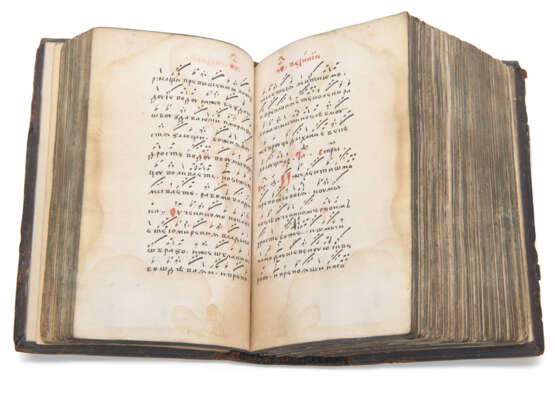ID 1053185
Lot 71 | Old Russian Neumes
Estimate value
£ 7 000 – 10 000
Festal Triodion, in Church Slavonic, musical manuscript on paper [Russia, early 17th century]
An early 17th-century Festal service book designed for the Easter to Whitsun period with demestvennayan neumes, in its contemporary binding.
153 x 106mm. i + v + 536 + ii + i leaves, mostly in gatherings of 8, gathering signatures survive on lower right corners of rectos, 11 lines in a condensed Cyrillic half-uncial by several different scribes, written space: 105 x 60mm., staffless diastematic (heightened) Old Russian neumes with occasional pomety in red, possibly demestvennayan neumes, some titles and initials in red, a headpiece in black in on f.1 (some light staining throughout, a few leaves frayed, some repairs, generally in good condition). Contemporary blind-stamped leather over boards sewn on 3 bands, blue and red head- and tail-bands, bevelled edges (lacking clasps, a little scuffed and worn).
Provenance:
(1) Sam Fogg, London, acquired in 1994 by:
(2) Schøyen Collection, MS 1843.
Text and music:
A Triodion is a book containing canons consisting of three odes. A Festal Triodion, like the present manuscript, is a book of music designed for the Easter to Whitsun period beginning on Palm Sunday. The text comprises: the end of the Office for Lazarus Sunday; Great Vespers for the Eve of Palm Sunday; the Offices for Passion Week; Holy Thursday and Saturday; the end of the Office of the 4th Sunday after Easter; Offices of the 5th and 6th Sunday after Easter; Pentecost and the Sunday of All Saints.
The notation in the present manuscript is close to that in MS. 763/690 in the Solovetsky Monastery Collection in the National Library of Russia. These are demestvennayan neumes, usually restricted to Cathedrals in large cities, a much more complex body of melodies than those in standard chants, designed to be performed by highly trained singers (see The New Grove Dictionary of Music and Musicians, 13, p.150).
| Place of origin: | Russia |
|---|---|
| Auction house category: | Medieval & renaissance manuscripts |
| Place of origin: | Russia |
|---|---|
| Auction house category: | Medieval & renaissance manuscripts |
| Address of auction |
CHRISTIE'S 8 King Street, St. James's SW1Y 6QT London United Kingdom | ||||||
|---|---|---|---|---|---|---|---|
| Preview |
| ||||||
| Phone | +44 (0)20 7839 9060 | ||||||
| Buyer Premium | see on Website | ||||||
| Conditions of purchase | Conditions of purchase |



